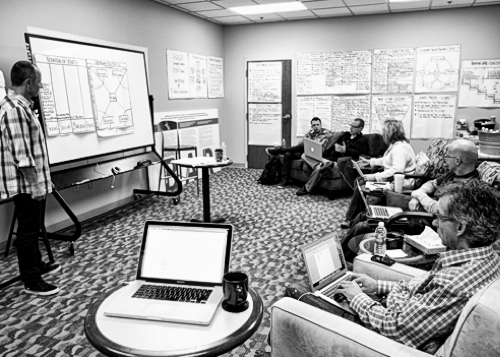
11 Secrets Church Leaders Are Struggling With
Leadership is a journey…a journey that’s probably different than you thought it would be before you stepped into leadership.
When I was young, I always thought leaders had it all figured out. That the uncertainty would one day disappear once I had more life and leadership under my belt.
But as you eventually learn, it doesn’t really work that way.
In fact, I think most leaders struggle more than they let on. I know personally, at one point or another, I’ve struggled in each of the areas listed below. But, at the time, because I didn’t want to tell anyone how I really felt, I kept mostly quiet.
Looking back, I realize for too long I kept far too much of it to myself.
You know what keeping it to yourself does, right? It leaves you isolated. And the silence gives fear power—power it should never have.
11 Secrets Most Church Leaders Won’t Tell You
Just to let you know you’re not alone, and to break the power of darkness by cracking some daylight, here are 11 secrets most leaders won’t tell you:
1. I’m less secure than I appear
The together exterior doesn’t always match the fragile interior.
Security is a journey for sure…a tough one. Most people don’t like insecure leaders. But insecurity is a trap…the more insecure you are, the more you resist telling anyone you’re insecure. And the more they dislike you.
If it helps, I outline 5 signs you’re an insecure leader in this post, and 5 ways to become a more secure leader here.
I think the best way to start dealing with your insecurity is to admit it, and deal with it. Counsellors’ offices and best friends are great places to start with that by the way. So is prayer.
2. Getting close to God isn’t easy
There’s a particular pressure on pastors and church leaders to have a ‘great’ relationship with God.
But the truth is, our relationship is just like anyone else’s relationship with God. It has ups and downs. Even as a church leader, you go through dry seasons. Okay, maybeespecially as a church leader, you go through dry seasons spiritually.
I think church leaders struggle with God in different ways than most people. I outline those ways here.
3. I’m lonelier than I let on
Leadership is complex and involves going through seasons of unpopularity. It also involves making tough calls that can make you the goat, or at least feel like a goat.
Add to that the fact that most of us who are driven type leaders don’t do relationships easily, and sometimes it’s lonelier than it needs to be.
4. It’s hard at home sometimes
Let’s just say it. Our Instagrams lie. It’s not always easy at home.
It’s gotten better over the years, but there have been seasons in my leadership where my family got too much of my unfiltered stress. Not fair. Not fair at all. But true.
Home is hard. Work is hard. Put the two together in an ill-thought through combination and it can be lethal. I really believe that, in the long run, everything rides on how you lead at home.
5. The criticism hurts
We pretend the criticism doesn’t hurt, but it does, whether we admit it or not.
We put our poker faces on, but deep down it stings.
Tell God. Tell somebody. And don’t let your family bear the brunt of it every time.
There are ways to make criticism sting less, but acknowledging it hurts is a great first step.
6. I’m afraid to ask for what I really want
I’ve usually been pretty forward in my leadership and I’m grateful for an incredibly honest dialogue I have with my staff and elder team where I serve.
But there are seasons where I’ve been afraid to ask for what I really want. And even as I type those words I think “That sounds so selfish.”
But sometimes you just need a vacation. Or, especially when your family is young and you’re just starting out, you need a raise. Or you need more staff. Or you need someone to have your back. Or you need a friend. You’re just afraid to ask.
You know what I’ve found? Almost every time I’ve asked, someone said “Why didn’t you ask sooner? We’d love to help.”
See what secrets and silence do?
7. I’ve thought about leaving even though I’m staying
You’ve thought about leaving, even though you’re staying…true? Of course it’s true, unless you just started last Tuesday, and even then…
Everyone goes through seasons of doubt and questions about the future.
But when you sit in silence with this one for too long, you end up waffling. Not staying, but not leaving either. You end up putting in half an effort, and you’re half the leader you could be.
Brad Lomenick offers some great insight in Episode 27 of my podcast about how to know when it’s time to go, and I outlined 5 signs it’s time to move on in this post.
8. My secret job is nothing like this job
One of the reasons leadership is hard is because you deal with so many intangibles. It’s brain work. People management. Conflict management. Getting people to do things they wouldn’t ordinarily do.
On bad days, many leaders I know dream of doing something entirely different. For a season, my escape job was to stack boxes in a warehouse. Because at least if you moved a box, it stayed moved.
9. I feel like I don’t really know what I’m doing
Eventually you reach a level of leadership, either because you’ve been at it long enough or because whatever you’re leading got big enough, that you realize there are no clear answers. There just aren’t.
You surrounded yourself with the smartest people you could and you realize that even the smart people don’t know what to do. That’s where real leadership begins—when you feel like you don’t really know what you’re doing, but you keep doing anyway.
That’s how history gets changed. You were just the last person standing, even though inside it felt like sheer confusion.
10. People seem to believe in me more than I believe in myself some days
When you’ve been through #9 enough times, you will be ready to give up believing in yourself. But you look around and realize other people keep believing in you. That’s exactly what you need. You’re likely leading very well if enough of the good people keep believing in you.
So when you stop believing in you, keep believing in the people who believe in you.
11. I thought we would have made more progress by now
You don’t want to say it out loud, but you really do think you would have made more progress by now.
You look at all the overnight successes and think “How come that wasn’t me?” This only works, of course, until you look more closely at the overnight successes only to realize almost all of them were 5-15 years in the making.
The fact that your vision is bigger than your reality is paradoxically a sign that you’re a good leader.
So keep being mildly disappointed, because it will always spur you on to more.
And one day when it’s over you’ll look back and be amazed at how much you actually accomplished.

Tags: Carey Nieuwhof, Leadership Secrets, Leadership Struggles, church leaders
















